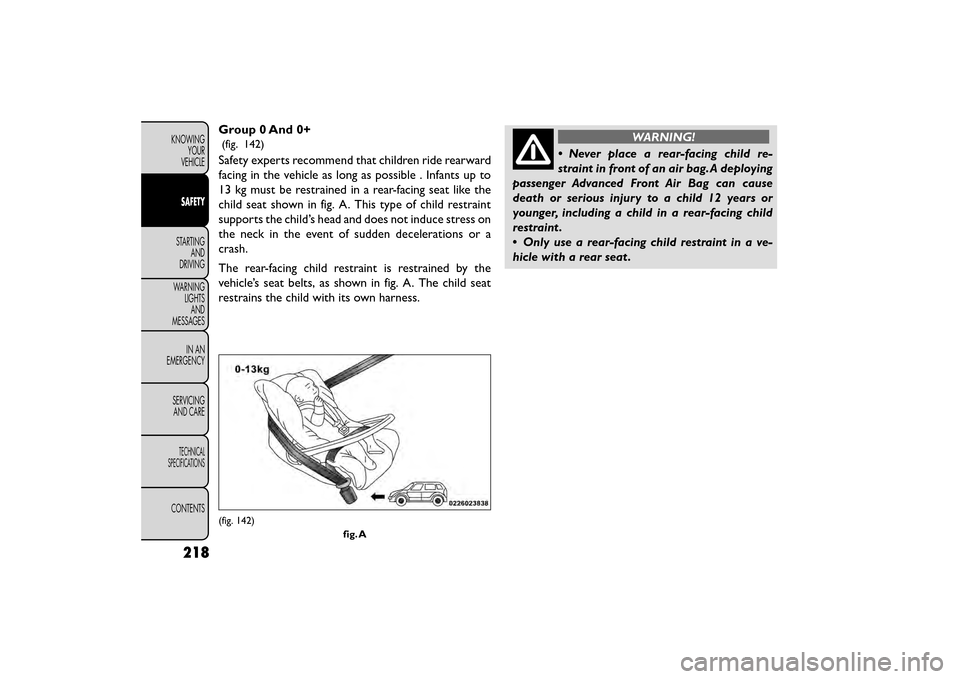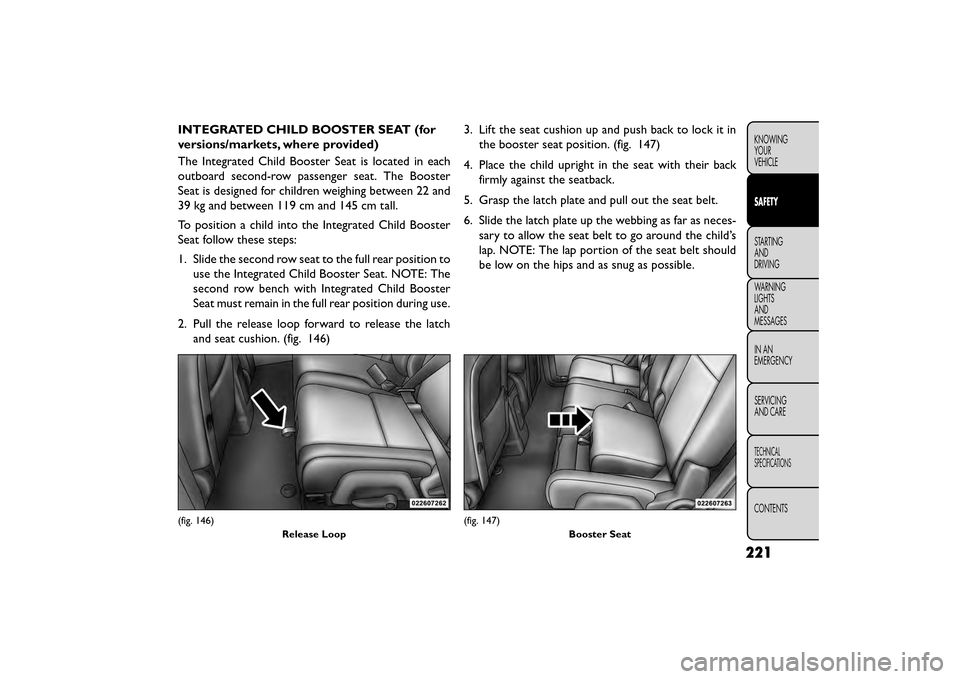Page 222 of 412

CHILD RESTRAINTS - CARRYING
CHILDREN SAFELY
(fig. 141)
Everyone in your vehicle needs to be buckled up at all
times, including babies and children. EC directive 2003/
20/EC requires proper use of restraints in all EC
countries.
Children less than 1.5 meters tall and 12 years or
younger should ride properly buckled up in a rear seat,
if available. According to crash statistics, children are
safer when properly restrained in the rear seats rather
than in the front.
WARNING!
In a collision, an unrestrained child can
becom e
a projectile inside the vehicle.
The force required to hold even an infant on your
lap could become so great that you could not
hold the child, no matter how strong you are.The
child and others could be badly injured. Any child
riding in your vehicle should be in a proper re-
straint for the child's size.
There are different sizes and types of restraints for
children from newborn size to the child almost large
enough for an adult safety belt. Children should ride
rearward facing as long as possible; this is the most
protected position for a child in the event of a crash.
Always check the child seat Owner’s Manual to make
sure you have the correct seat for your child. Carefully
read and follow all the instructions and warnings in the
child restraint Owner’s Manual and on all the labels
attached to the child restraint.
(fig. 141)
216
KNOWING YOUR
VEHICLE
SAFETY
STARTING AND
DRIVING
WARNING LIGHTSAND
MESSAGES
IN
AN
EMERGENCY
SERVICINGAND CARE
TECHNICAL
SPECIFICATIONS
CONTENTS
Page 223 of 412

In Europe, children restraint systems are defined by
regulation ECE-R44, which divides them into five
weight groups:
Restraint GroupWeight Group
Group0 upto10kg
Group 0+ up to 13 kg
Group 1 9-18 kg
Group 2 15-25 kg
Group 3 22-36 kg
Check the label of your child restraint. All approved
child restraints must include type-approval data and
the control mark on its label. The label must be
permanently secured to the child restraint system. You
should not remove this label from the child restraint.
WARNING!
Extreme Hazard! Do not place rearward
facin g
infant seat in front of an active air
bag. Refer to visor and door shut face mounted
labels for information. Deployment of the air bag
in an accident could cause fatal injuries to the
baby regardless of the severity of the collision. It
is advisable to always carry children in a child
restraint system on the rear seat , which is the
most protected position in the event of a colli-
sion.
“UNIVERSAL” CHILD RESTRAINT
SYSTEMS
The figures in the following sections are examples of
each type of universal child restraint system. Typical
installations are shown. Always install your child re-
straint system according to the child restraint manu-
facturer’s instructions, which must be included with
this type of restraint system.
217
KNOWING
YOUR
VEHICLE
SAFETY
STARTING
AND
DRIVING
WARNING
LIGHTS
AND
MESSAGES
IN
AN
EMERGENCY
SERVICING
AND CARE
TECHNICAL
SPECIFICATIONS
CONTENTS
Page 224 of 412

Group 0 And 0+
(fig. 142)
Safety experts recommend that children ride rearward
facing in the vehicle as long as possible . Infants up to
13 kg must be restrained in a rear-facing seat like the
child seat shown in fig. A. This type of child restraint
supports the child’s head and does not induce stress on
the neck in the event of sudden decelerations or a
crash.
The rear-facing child restraint is restrained by the
vehicle’s seat belts, as shown in fig. A. The child seat
restrains the child with its own harness.
WARNING!
• Never place a rear-facing child re-
s t
raint in front of an air bag. A deploying
passenger Advanced Front Air Bag can cause
death or serious injury to a child 12 years or
younger, including a child in a rear-facing child
restraint .
• Only use a rear-facing child restraint in a ve-
hicle with a rear seat .
(fig. 142)
fig. A
218
KNOWINGYOUR
VEHICLE
SAFETY
STARTING AND
DRIVING
WARNING LIGHTSAND
MESSAGES
IN
AN
EMERGENCY
SERVICINGAND CARE
TECHNICAL
SPECIFICATIONS
CONTENTS
Page 225 of 412
Group 1
(fig. 143)
Children who weigh between 9 kg and 18 kg may be
carried in a Group 1, forward facing seat like the one in
fig. B. This type of child restraint is for older children
who are too big for a Group 0 or 0+ child restraint.Group 2
(fig. 144)
Children who weigh between 15 kg and 25 kg and who
are too big for the Group 1 child restraint may use a
Group 2 child restraint system.
As shown in fig. C, the Group 2 child restraint system
positions the child correctly with respect to the seat
belt so that the shoulder belt crosses the child’s chest
and not the neck, and the lap belt is snug on the pelvis
and not the abdomen.
(fig. 143)
fig. B(fig. 144)fig. C
219
KNOWING
YOUR
VEHICLE
SAFETY
STARTING
AND
DRIVING
WARNING
LIGHTS
AND
MESSAGES
IN
AN
EMERGENCY
SERVICING
AND CARE
TECHNICAL
SPECIFICATIONS
CONTENTS
Page 226 of 412

Group 3
(fig. 145)
Children who weigh between 22 kg and 36 kg and who
are tall enough to use the adult shoulder belt may use
a Group 3 child restraint. Group 3 child restraints
position the lap belt on the child’s pelvis. The child
must be tall enough that the shoulder belt crosses the
child’s chest and not their neck.
fig. D shows an example of a Group 3 child restraint
system correctly positioning the child on the rear seat.
WARNING!
• Improper installation can lead to fail-
ure of
an infant or child restraint . It
could come loose in a collision.The child could be
badly injured or killed. Follow the child restraint
manufacturer ’s directions exactly when install-
ing an infant or child restraint .
• After a child restraint is installed in the vehicle,
do not move the vehicle seat forward or rearward
because it can loosen the child restraint attach-
ments. Remove the child restraint before adjust-
ing the vehicle seat position. When the vehicle
seat has been adjusted, reinstall the child re-
straint.
• When your child restraint is not in use, secure it
in the vehicle with the seat belt or ISOFIX an-
chorages, or remove it from the vehicle. Do not
leave it loose in the vehicle. In a sudden stop or
accident , it could strike the occupants or seat-
backs and cause serious personal injury.
(fig. 145)
fig. D
220
KNOWINGYOUR
VEHICLE
SAFETY
STARTING AND
DRIVING
WARNING LIGHTSAND
MESSAGES
IN
AN
EMERGENCY
SERVICINGAND CARE
TECHNICAL
SPECIFICATIONS
CONTENTS
Page 227 of 412

INTEGRATED CHILD BOOSTER SEAT (for
versions/markets, where provided)
The Integrated Child Booster Seat is located in each
outboard second-row passenger seat. The Booster
Seat is designed for children weighing between 22 and
39 kg and between 119 cm and 145 cm tall.
To position a child into the Integrated Child Booster
Seat follow these steps:
1. Slide the second row seat to the full rear position touse the Integrated Child Booster Seat. NOTE: The
second row bench with Integrated Child Booster
Seat must remain in the full rear position during use.
2. Pull the release loop forward to release the latch and seat cushion. (fig. 146) 3. Lift the seat cushion up and push back to lock it in
the booster seat position. (fig. 147)
4. Place the child upright in the seat with their back firmly against the seatback.
5. Grasp the latch plate and pull out the seat belt.
6. Slide the latch plate up the webbing as far as neces- sary to allow the seat belt to go around the child’s
lap. NOTE: The lap portion of the seat belt should
be low on the hips and as snug as possible.
(fig. 146)
Release Loop(fig. 147) Booster Seat
221
KNOWING
YOUR
VEHICLE
SAFETY
STARTING
AND
DRIVING
WARNING
LIGHTS
AND
MESSAGES
IN
AN
EMERGENCY
SERVICING
AND CARE
TECHNICAL
SPECIFICATIONS
CONTENTS
Page 228 of 412
7. Once the seat belt is long enough to fit properly,insert the latch plate into the buckle until you hear
a “click.” (fig. 148)
8. To remove the slack from the lap belt, pull upward on the shoulder portion of the seat belt.
9. To release the seat belt, push the red button on the buckle.WARNING!
Securely lock the seat cushion into posi-
ti on
before using the seat . Otherwise,
the seat will not provide the proper stability for
child seats and/or passengers. An improperly
latched seat cushion could cause serious injury.
(fig. 148)
Proper Belt Use
222
KNOWINGYOUR
VEHICLE
SAFETY
STARTING AND
DRIVING
WARNING LIGHTSAND
MESSAGES
IN
AN
EMERGENCY
SERVICINGAND CARE
TECHNICAL
SPECIFICATIONS
CONTENTS
Page 229 of 412
SUITABILITY OF PASSENGER SEATS FOR
UNIVERSAL CHILD RESTRAINT SYSTEM
USE
According to the European Directive 2000/3/EC, the
suitability of each passenger seat position for the instal-
lation of Universal Child Restraint Systems is shown in
the following table:
Mass GroupSeating Position (or other site)
Front
Passenger Rear
Outboard Rear Center Intermediate
Outboard Intermediate
Center
Group0—upto 10 kg X U N/A U U
Group 0+ — up to 13 kg X U N/A U U
Group1–9to 18 kg X U N/A U U
Group II – 15 to 25 kg X U N/A U U
Group III — 22 to 36 kg X U N/A U U
Key of letters used in the table above
U = Suitable for “universal” category restraints ap-
proved for use in this mass group
X = Seat position no suitable for children in this mass
group
223
KNOWING
YOUR
VEHICLE
SAFETY
STARTING
AND
DRIVING
WARNING
LIGHTS
AND
MESSAGES
IN
AN
EMERGENCY
SERVICING
AND CARE
TECHNICAL
SPECIFICATIONS
CONTENTS